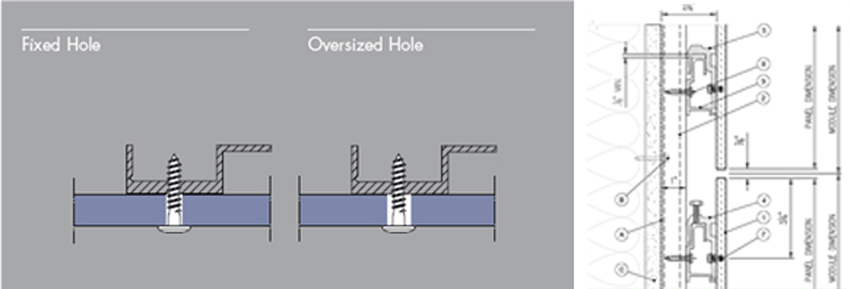High-Pressure Laminates in Rainscreen Facade
Panel Installation
There are two fundamental choices for securing the HPL panels to the support system. One is to use exposed fasteners through the face of the panels. Commonly, these fasteners can be painted to match the color of the HPL and blend in quite well, particularly when viewed from a bit of distance as most facades are. The fasteners must be spaced properly according to the manufacturer’s recommendations for the product. Every panel needs fixed points and sliding points, including some with oversized holes to accommodate movement. Information on how to position/place these points is provided in technical information from manufacturers.
The second way that HPL panels can be secured in place is to use a concealed fastener system. This creates a cleaner look, particularly when viewed up close, say along a sidewalk or other areas where people will frequent. Concealed systems rely on the addition of horizontal aluminum channels that are designed to receive corresponding inverted channels or clips that are secured onto the back of the HPL panels. These systems commonly include some means of adjustment to level the panels and a means to permanently secure the hanging panels in place.
Regardless of the method of attachment, HPL panels are generally quite accepted by tradesmen because they bring several installation advantages. First, if the design calls for it, the availability of large-size panels reduces installation time and allows for quicker, more economical installations. Second, HPL can be fabricated in a controlled manufacturing site with computer numerical control (CNC) machined accuracy as well as field cut. It is machined and installed using the same conventional carpentry tools as used for hardwood. That means there is very little if any learning curve since experienced carpenters can readily discern how to work with and install the products. Third, the comparative thinness of the product means that renovation projects can benefit from installation over existing materials, thus avoiding the time and cost of demolition and waste disposal.
Of course, just like any manufactured product, HPL panels should always be installed per the manufacturer's recommendations for the specific application in which they are being used. In this way, any warranties can be preserved and the best performance can be assured.

Images courtesy of Trespa North America Ltd.
HPL panels can be installed on aluminum support systems using either an exposed fastener method or concealed fastener system.











